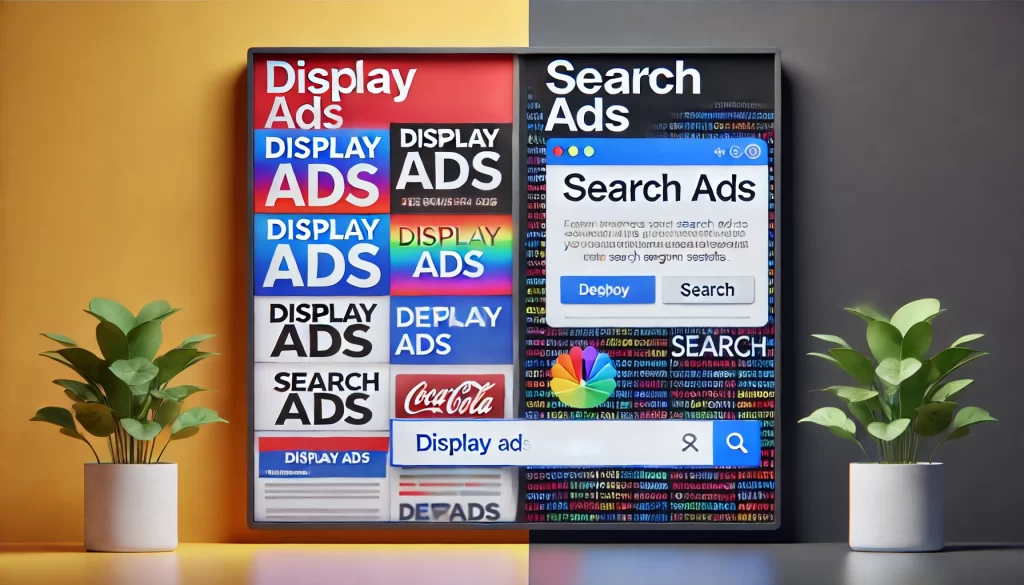Introduction
Google Ads provides businesses with powerful tools for reaching potential customers, and two of the most common formats available are Display Ads and Search Ads. While both are effective in their ways, understanding the differences between them is crucial for developing a successful advertising strategy. Whether you’re trying to drive immediate traffic to your website or build brand awareness over time, the choice between display and search ads can significantly impact your results. We’ll explore the differences between Google Display Ads and Search Ads, compare their advantages, and provide examples of social media ads to help you make an informed decision. We’ll also offer best practices for optimizing your campaigns and highlight the different formats and sizes of display ads to ensure your ads perform at their best.

Google Display Ads vs. Search Ads
To start, it’s important to understand the key differences between Display Ads and Search Ads, as these distinctions will guide your ad strategy and ensure you’re targeting the right audience effectively.
Key Differences Between Display and Search Ads
At their core, Search Ads and Display Ads target users at different stages of the customer journey. Understanding these differences can help you decide which type of ad to run.
- Search Ads: These ads appear when a user actively searches for a specific query or keyword on Google. When someone types in a search term related to your product or service, your ad will appear at the top or bottom of the search results. These ads are highly intent-driven, meaning that the user is already looking for information or a solution, which often leads to higher conversion rates.
- Display Ads: Display ads, on the other hand, are visually appealing banner ads that appear on websites within Google’s Display Network. They are shown to users as they browse different websites, use apps, or watch YouTube videos. These ads are ideal for brand awareness and targeting users who may not yet be actively searching for your products but are still within your target audience.
Advantages of Display Ads for Brand Awareness
Display Ads are highly effective for creating brand awareness. These ads allow businesses to reach a broader audience and showcase their products in a more visually engaging way. Key benefits include:
- Visual Appeal: Display ads use images, animations, and videos, making them ideal for visually-driven marketing. This can capture the attention of potential customers who might not otherwise engage with text-based ads.
- Large Reach: The Google Display Network reaches over 90% of internet users worldwide, meaning your brand can be seen across millions of websites, apps, and videos. This expansive reach helps businesses introduce their brand to new audiences.
- Retargeting Opportunities: Display ads allow for remarketing, which means you can re-engage users who have previously visited your website but did not convert. This keeps your brand top of mind and encourages users to return.
Related Posts:
- Google Ads Specifications
- Understanding Google Ads: Features and Benefits
- Comparing Display Ads vs. Search Ads
Advantages of Search Ads for Targeting Specific Queries
Search Ads are powerful for targeting users with specific intent. When someone searches for a relevant keyword, your ad appears alongside organic search results, making it easier to capture their attention at the moment they’re most interested in your service. Key benefits of search ads include:
- High Intent: Search ads are driven by user intent. When someone searches for terms like “best home inspector near me” or “affordable tree service,” they are likely already in the decision-making process, which makes search ads effective at driving conversions.
- Cost-Effective: Because search ads are based on a pay-per-click (PPC) model, you only pay when a user clicks on your ad. Since these clicks are from users actively searching for your product, the likelihood of conversions is higher, often resulting in a better return on investment (ROI).
- Precise Targeting: With search ads, you can target specific keywords related to your business, ensuring that your ads are only shown to users who are searching for exactly what you offer.

Examples of Social Media Ads
Social media ads, such as those on Facebook and Instagram, also offer unique targeting and engagement opportunities. While Google Ads focuses on search and display, social media platforms focus on building relationships and engaging with audiences visually. Here’s a comparison between Google Ads and social media ads:
Types of Social Media Ads
Social media ads can be created in a variety of formats depending on the platform. Some popular types of ads include:
- Facebook Ads: These can be carousel ads, image ads, video ads, or slideshow ads, often incorporating user engagement features such as likes, comments, and shares.
- Instagram Ads: Instagram offers photo and video ads that can appear in the feed or on Instagram Stories. These visually compelling ads are great for businesses with products or services that benefit from eye-catching visuals.
- LinkedIn Ads: Ideal for B2B businesses, LinkedIn offers text ads, image ads, and sponsored InMail, allowing for targeted professional engagement.
Related Posts:
- Setting Up Local Service Ads: Boost Your Local Business
- Comparing Display Ads vs. Search Ads
- Google Ads Specifications
Comparing Social Media Ads to Google Ads
While Google Ads allows you to target users based on intent (searching for a specific product or service), social media ads target users based on interest, demographics, and behaviors. Both have their benefits, but they cater to different stages of the customer journey:
- Google Ads is better for reaching users who are actively searching for products or services, driving immediate conversions.
- Social Media Ads work better for brand awareness, nurturing leads, and building long-term relationships with customers.
Optimizing Ads for Better Performance
Whether you’re using Display Ads or Search Ads, optimizing your ads for better performance is key to achieving your business goals. Understanding your objectives will help you decide which type of ad to use and how to make it as effective as possible.
How to Decide Which Type of Ad to Use Based on Your Goal
- For Immediate Sales or Conversions: Search Ads are ideal if your goal is to drive immediate sales or conversions. Search ads capture users who are already searching for a solution to their problem.
- For Brand Awareness: Display Ads are better suited for building brand awareness, especially if you’re trying to reach a broad audience or re-engage past visitors.
- For Retargeting: Both ad types can be used for retargeting, but Display Ads excel in keeping your brand top of mind as users browse the web.
Best Practices for Each Type of Ad
- For Display Ads: Ensure your creatives are eye-catching and use a clear call-to-action (CTA). Test different sizes and formats to see what works best across devices.
- For Search Ads: Focus on writing relevant, compelling ad copy that directly addresses the user’s query. Use strong CTAs like “Buy Now” or “Get a Free Quote.”
Google Display Ads Size and Format
One of the most important factors in creating effective Display Ads is understanding the right sizes and formats for your campaigns. Different ad sizes perform better depending on the placement and the device.
A Deep Dive into Different Ad Formats and Sizes for Display Campaigns
Google offers several display ad sizes, each with its unique use cases. Some of the most popular formats include:
- Medium Rectangle (300×250): Ideal for mobile devices and often placed within content, making it one of the most common ad sizes.
- Leaderboard (728×90): A larger horizontal ad typically used in website headers.
- Wide Skyscraper (160×600): A vertical ad best used for sidebars, where it is more likely to be seen by users.
- Mobile Banner (320×50): Designed for mobile devices, this small banner ad ensures visibility on smaller screens.
Choosing the right format depends on your ad placement, target audience, and goals.
Choosing the Right Format for Your Campaign
If your goal is to reach a broad audience and maximize visibility, the Leaderboard or Wide Skyscraper may work best. For targeting mobile users specifically, go with the Mobile Banner or Medium Rectangle.
Key Takeaways
Choosing between Display Ads and Search Ads depends largely on your business goals. Both ad formats have their advantages and can be highly effective when used in the right context. Understanding the benefits of each whether it’s driving immediate conversions with search ads or boosting brand awareness with display ads will help you craft more effective, results-driven campaigns.
Remember to test different strategies, refine your targeting, and continuously optimize your ads to ensure you get the best results for your business.
Understanding the differences between Display Ads and Search Ads is crucial for crafting effective advertising campaigns. Display Ads are excellent for brand awareness and broad targeting, while Search Ads are perfect for capturing users with high intent. By optimizing your campaigns and using the right ad format for your goals, you can achieve better results and increase your ROI.
- Display Ads: Great for brand awareness, broad targeting, and retargeting.
- Search Ads: Best for targeting high-intent users actively searching for solutions.
- Ad Optimization: Tailor your campaigns to your business goals, whether it’s conversions or awareness.
- Testing: Regularly test and refine your ads for continuous improvement.
FAQs
What are the key differences between Display Ads and Search Ads?
Display Ads are visually engaging and great for brand awareness, while Search Ads are driven by user intent and tend to lead to higher conversion rates.
When should I use Display Ads over Search Ads?
Use Display Ads if your goal is to reach a broad audience or build brand awareness. Use Search Ads when you want to target users actively searching for a specific product or service.
How do I optimize my Display Ads for better performance?
Make sure your creatives are visually compelling, use clear CTAs, and test different formats to see which ones work best across devices and placements.
How can I track the performance of my Google Ads campaigns?
Google Ads offers detailed analytics, including CTR, conversion rates, and ROI. Use this data to optimize your campaigns and improve ad performance.
Can I use both Display Ads and Search Ads in the same campaign?
Yes, combining both types of ads can be an effective strategy for reaching users at different stages of the customer journey.
